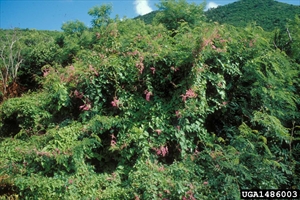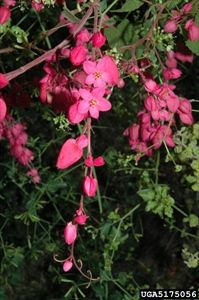- Worldwide distribution. Recorded in 18 Pacific island countries, but NOT Tokelau, Tuvalu or Vanuatu.
- Aggressive, fast-growing weed, tolerant of different environments, but preferring disturbed dry to moist limestone soils, producing tubers, large amounts of seed (with long viability) and regrowing from stem pieces. Often escaping cultivation, impacting biodiversity by smothering native trees, shrubs and understory plants along roadsides, on wastelands, riverbanks, dry coral cliffs, in swamps, and dry lowland (including coastal) forests.
- Stems woody up to12m, angular to 5-sided. Leaves alternate, oval or heart-shaped, reddish stalks 1-5cm. Flower in pink branched clusters, terminal and from leaf axils, up to 20cm, ending in tendril. Fruits in remains of dead petals.
- Spread: seed by birds, other animals; long distances by movement of soil and plants as ornamentals.
- Biosecurity: regulate horticultural trade, unofficial movement of plants between countries, Internet sales.
- Biocontrol: none.
- Cultural control: pull-up basal stem with root and tubers; slash, mow or burn, using herbicide on regrowth.
- Chemical control: triclopyr or glyphosate as: i) foliar sprays; ii) sprays on regrowth after slashing; iii) onto cut stumps.








